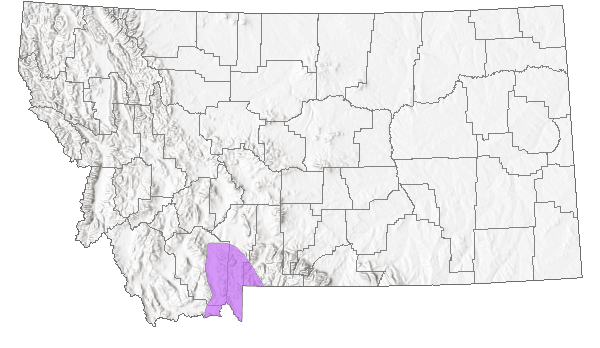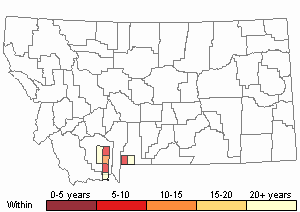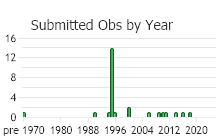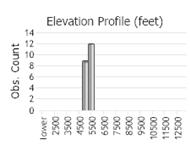View in other NatureServe Network Field Guides
NatureServe
Montana
Utah
Wyoming
Idaho
Wisconsin
British Columbia
South Carolina
Yukon
California
New York
Spiny Skeletonweed - Pleiacanthus spinosus
Other Names:
Stephanomeria spinosa, Lygodesmia spinosa
State Rank Reason (see State Rank above)
Pleiacanthus spinosus occurs in Montana at the northeastern edge of its range, where it is known only from grasslands in the Madison Valley. Currently, there are only a few extant occurrences and three historical collections from this area. No specific threats have been reported. Trend data are not available. However, parts of the Madison Valley are being subdivided and habitat is likely to be negatively impacted.
- Details on Status Ranking and Review
Population Size
Score2 - Small: Generally 2,000-10,000 individuals.
CommentAdditional populations are probably present within the Madison River Drainage.
Range Extent
Score2 - Regional or State Endemic or Small Montana Range: Generally restricted to an area <100,000 sq. miles (equivalent to 2/3 the size of Montana or less) or Montana contributes 50% or more of the species’ range or populations OR limited to 2-3 Sub-basins in Montana.
Area of Occupancy
Score2 - Low: Generally occurring in 4-10 Subwatersheds (6th Code HUC’s).
CommentAdditional populations are probably present within the Madison River Drainage.
Environmental Specificity
Score1 - Moderate: Species is restricted to a specific habitat that is more widely distributed or to several restricted habitats and is typically dependent upon relatively unaltered, good-quality habitat (C Values of 5-7).
Trends
ScoreNA - Rank factor not assessed.
Threats
Score1-2 - Medium to High.
CommentMost occurrences are documented on a patchwork of public land surrounded by private lands within the Madison River Valley. Some development is occuring within the valley, which may detrimentally impact some populations or its habitat. Invasive weeds are also a concern.
Intrinsic Vulnerability
Score0-1 - Low to Moderate Vulnerability.
CommentSpecies does not appear to have specific traits that make it vulnerable.
Raw Conservation Status Score
Score
8 to 10 total points scored out of a possible 16 (Rarity factors and threats only).
General Description
Taprooted perennial with a brown-wooly branched crown. Stems erect, spine-tipped, 15–40 cm, branched. Herbage glabrate to weakly tomentose with milky sap. Leaves alternate, cauline, linear, entire, 5–30 mm long, inconspicuous. Inflorescence heads solitary on upper spine-like branches. Heads ligulate; involucre cylindric, 7–13 mm high; phyllaries linear-oblanceolate in 2 series, the outer short; receptacle flat, naked. Ray flowers 3 to 5, perfect, pinkish. Pappus 2 series of minutely barbed bristle in 2 series, tan. Achenes tubular, 6–8 mm long, 5-ribbed, glabrous (
Lesica et al. 2012. Manual of Montana Vascular Plants. BRIT Press. Fort Worth, TX).
Phenology
Flowering occurs in July - August.
Diagnostic Characteristics
These plants can be confused by their common name, scientific name, and/or initial appearance because at some point they can exhibit green or brown stems that are leafless or inconspicuously leafy.
Here is how to differentiate them:
Spiny Skeletonweed -
Pleiacanthus spinosus, native, SOC:
* In Aster Family; pinkish flowerheads occur solitary on upper branches. About 3 florets per flowerhead.
* Achenes are not beaked, but are tubular.
* Plants have a milky sap.
* Plants have hairs, being glabrate to weakly tomentose.
* Plants are taprooted with a brown-woolly branched crown.
* Stems are spine-tipped and branched.
Rush skeletonweed -
Chondrilla juncea, exotic and Noxious:
* In Aster Family; yellow flowerheads occur at the tips of stems or in the axils of leaves. About 7-15 florets per flowerhead.
* Achenes (fruits) have a beak of 5-6mm long.
* Stems, leaves, and inflorescence have milky sap.
* Plants have hairs being hirsute to glabrate. On the lower 10-15 cm (4-6 inches) of the stem the hairs point downward while the upper stem is lacks hairs or has a few rigid hairs.
* Plants are taprooted perennial forbs.
Rush Skeleton-plant -
Lygodesmia juncea, native:
* In Aster Family; pinkish flowerheads occur at the tips of stems. About 5 florets per flowerhead.
* Achenes are not beaked, but sometimes are fusiform.
* Plants lack milky sap.
* Plants are without hairs (glabrous).
* Plants are rhizomatous perennial forbs.
Tall Tumble-mustard -
Sisymbrium altissimum, exotic:
* In Mustard Family; flowers with 4 (pale) yellow petals and 4 green to yellowish sepals.
* Stems are leafy with large pinnately lobed leaves.
* In fruit or during the winter stems appear leafless. Plants branch, becoming round.
* Fruit is a long and narrow silique that is equal in width to its stem (pedicel).
Species Range
Montana Range
Range Descriptions

 Native
Native
Range Comments
MT, ID and OR, south to CA and AZ.
Observations in Montana Natural Heritage Program Database
Number of Observations: 32
(Click on the following maps and charts to see full sized version)
Map Help and Descriptions
Relative Density

Recency



 (Observations spanning multiple months or years are excluded from time charts)
(Observations spanning multiple months or years are excluded from time charts)
Habitat
In Montana, spiny skeletonweed is known from Madison County, where it occupies arid grasslands on stony loam at lower elevations (5000-6400 feet). Agropyron spicatum typically dominates, however Stipa comata, Festuca idahoensis, Bouteloua gracilis, and ground cover of Selaginella densa are locally co-dominant or abundant. Associates include Antennaria rosea, Artemisia frigida, Astragalus adsurgens, Astragalus terminalis, Heterotheca villosa, Gutierrezia sarothrae, Koeleria macrantha, Musineon divaricatum, Oxytropis sericea, Phlox hoodii, Poa secunda, and Senecio canus.
Ecological Systems Associated with this Species
- Commonly Associated with these Ecological Systems
Grassland Systems
Ecology
Spiny skeletonweed reproduces strictly by seed. Its paucity of leaves and its occurrence in sparsely vegetated, semi-arid grassland or shrubland suggest that this species is adapted to full sun and may not compete well with other plants for light. The spine-tipped branches undoubtedly deter grazing.
Management
Field observations have yielded no indication as to whether this species is affected by livestock grazing. However, grazing would likely favor this plant because it is probably unpalatable and would benefit from a reduction in competing palatable grasses.
Stewardship Responsibility
Threats or Limiting Factors
STATE THREAT SCORE REASON
Reported threats to Montana's populations of Spiny Skeletonweed (Pleiacanthus spinosus) are currently assigned as unknown. Potential threats due to residential development, non-native species, and herbicide application need to be substantiated before a threat rank can be assigned (MTNHP Threat Assessment 2021).
References
- Literature Cited AboveLegend:
 View Online Publication
View Online Publication Lesica, P., M.T. Lavin, and P.F. Stickney. 2012. Manual of Montana Vascular Plants. Fort Worth, TX: BRIT Press. viii + 771 p.
Lesica, P., M.T. Lavin, and P.F. Stickney. 2012. Manual of Montana Vascular Plants. Fort Worth, TX: BRIT Press. viii + 771 p. MTNHP Threat Assessment. 2021. State Threat Score Assignment and Assessment of Reported Threats from 2006 to 2021 for State-listed Vascular Plants. Botany Program, Montana Natural Heritage Program, Helena, Montana.
MTNHP Threat Assessment. 2021. State Threat Score Assignment and Assessment of Reported Threats from 2006 to 2021 for State-listed Vascular Plants. Botany Program, Montana Natural Heritage Program, Helena, Montana.
- Additional ReferencesLegend:
 View Online Publication
View Online Publication
Do you know of a citation we're missing? Heidel, B.L. and J. Vanderhorst. 1996. Sensitive plant species surveys in the Butte District, Beaverhead and Madison Counties. Unpublished report to the Bureau of Land Management. Montana Natural Heritage Program, Helena, Montana.
Heidel, B.L. and J. Vanderhorst. 1996. Sensitive plant species surveys in the Butte District, Beaverhead and Madison Counties. Unpublished report to the Bureau of Land Management. Montana Natural Heritage Program, Helena, Montana. Lesica, P., M.T. Lavin, and P.F. Stickney. 2022. Manual of Montana Vascular Plants, Second Edition. Fort Worth, TX: BRIT Press. viii + 779 p.
Lesica, P., M.T. Lavin, and P.F. Stickney. 2022. Manual of Montana Vascular Plants, Second Edition. Fort Worth, TX: BRIT Press. viii + 779 p. Quire, R.L. 2013. The sagebrush steppe of Montana and southeastern Idaho shows evidence of high native plant diversity, stability, and resistance to the detrimental effects of nonnative plant species. M.Sc. Thesis. Bozeman, MT: Montana State University. 124 p.
Quire, R.L. 2013. The sagebrush steppe of Montana and southeastern Idaho shows evidence of high native plant diversity, stability, and resistance to the detrimental effects of nonnative plant species. M.Sc. Thesis. Bozeman, MT: Montana State University. 124 p.
- Web Search Engines for Articles on "Spiny Skeletonweed"





